Vas Cath for Dialysis is a Large Bore Central Venous Catheter Line placed in the Jugular Vein or Femoral Vein and used for Dialysis to address Kidney Disease and Renal Failure. Vas Cath is a temporary dialysis catheter which can typically be used for up to 30 to 45 days. Vas Cath provides a temporary alternative to Arteriovenous fistula (AV Fistula) and Arteriovenous graft (AV Graft) for dialysis access and treatment and this page further describes its use.
Vas Cath for Dialysis is a Large Bore Central Venous Catheter Line placed in the Jugular Vein or Femoral Vein and used for Dialysis to address Kidney Disease and Renal Failure. Vas Cath is a temporary dialysis catheter which can typically be used for up to 30 to 45 days. Vas Cath provides a temporary alternative to Arteriovenous fistula (AV Fistula) and Arteriovenous graft (AV Graft) for dialysis access and treatment and this page further describes its use.
Kidney Disease or Renal Failure
Kidney Disease or Renal Failure is the malfunction of the Kidney causing the Kidney to lose its filtering ability. As a result of Kidney disease, Kidney failure or Kidney injury, the Kidney shuts down and waste accumulates in the body and the body’s chemical balance gets disrupted. The body is designed to protect the brain, heart, and lungs and thus, when there is trauma or disease, the body will direct all resources including blood to protect those three organs causing the Kidney to lose support and functionality. Symptoms of Kidney Disease or Renal Failure include fluid retention, fatigue, shortness of breath and decreased urine output.
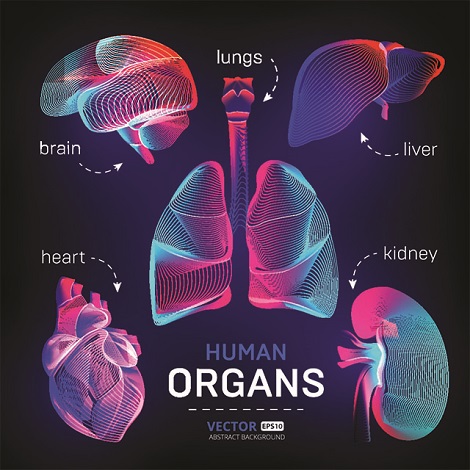
Human Body prioritizes Brain, Heart, and Lungs over the Kidney and Liver
Kidney Disease or Renal Failure
Kidney Disease or Renal Failure is the malfunction of the Kidney causing the Kidney to lose its filtering ability. As a result of Kidney disease, Kidney failure or Kidney injury, the Kidney shuts down and waste accumulates in the body and the body’s chemical balance gets disrupted. The body is designed to protect the brain, heart, and lungs and thus, when there is trauma or disease, the body will direct all resources including blood to protect those three organs causing the Kidney to lose support and functionality. Symptoms of Kidney Disease or Renal Failure include fluid retention, fatigue, shortness of breath and decreased urine output.

Human Body prioritizes Brain, Heart, and Lungs over the Kidney and Liver
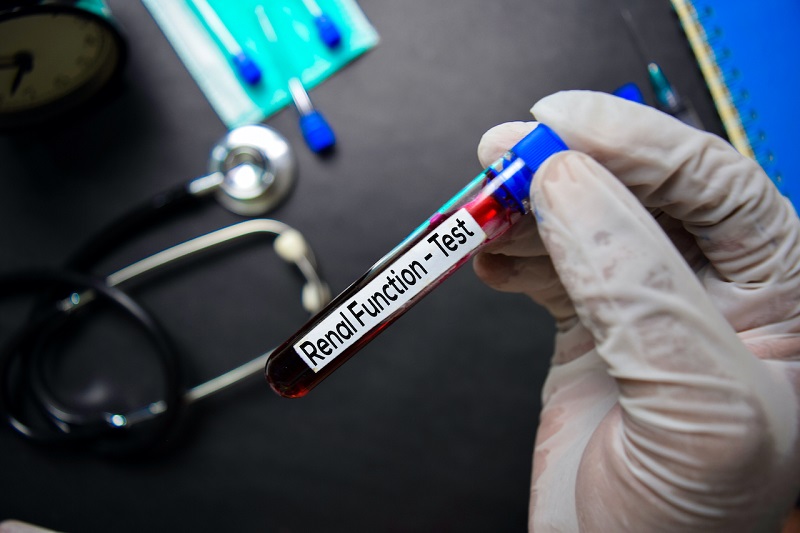
Renal Failure is confirmed by blood labs testing BUN, Creatine, Electrolyte and other markers
Temporary Renal Failure
Temporary Renal Failure can occur and be reversed, allowing the Kidney to return to full functionality. For example, in the case of physical trauma to the body such as in a serious car accident, the body will direct resources to protect other vital organs. The Kidney will start to falter, traditional symptoms will manifest, and blood labs will document the failure. However, as the body stabilizes and heals, the Kidney can as well, sometimes on its own and sometimes with the help of temporary dialysis to perform the function of the Kidney while the Kidney is recovering. Vas Cath Placement can be an effective, efficient and less intrusive procedure than more permanent options such as AV Fistula and AV Graft to enable dialysis.
Temporary Renal Failure
Temporary Renal Failure can occur and be reversed, allowing the Kidney to return to full functionality. For example, in the case of physical trauma to the body such as in a serious car accident, the body will direct resources to protect other vital organs. The Kidney will start to falter, traditional symptoms will manifest, and blood labs will document the failure. However, as the body stabilizes and heals, the Kidney can as well, sometimes on its own and sometimes with the help of temporary dialysis to perform the function of the Kidney while the Kidney is recovering. Vas Cath Placement can be an effective, efficient and less intrusive procedure than more permanent options such as AV Fistula and AV Graft to enable dialysis.

Renal Failure is confirmed by blood labs testing BUN, Creatine, Electrolyte and other markers
Vas Cath Placement at the Bedside
Vas Cath Placement at the Bedside is performed by Shoals Kidney Center, and can be advantageous. While Vas Cath Lines can be placed in the interventional radiology department by hospital clinicians, placement of these Lines at the Bedside by Vascular Access Clinicians can prove valuable. Vas Cath insertion and placement at the bedside can be beneficial for many of the same reasons other Central Venous Lines at the bedside can be preferable including more effective infection control, decreased transportation time and expense, easier coordination of treatment, less patient disruption, decreased length of stay for the patient, and improved efficiency and use of resources such as facilities, equipment, supplies and medical specialists. Since Vas Cath Lines serve the important purpose of the Kidney function, speed is critical especially in the case of suspected Temporary Renal Failure where Kidney preservation and restoration is feasible and desirable. Vascular Access clinicians who can provide Vas Cath placement at the bedside and then read a confirmation X-Ray to confirm tip placement, can clear the Vas Cath Line for usage often much quicker than other options. Contrast Dye Neuropathy (CIN) rates are high in the renal population and using the bedside dye-free approach and ultrasound eliminates this risk. Vas Cath or Temporary Dialysis Catheters at the Bedside serve the important purpose of providing immediate care without disrupting future care options enabling the patient’s care plan to be carefully developed.
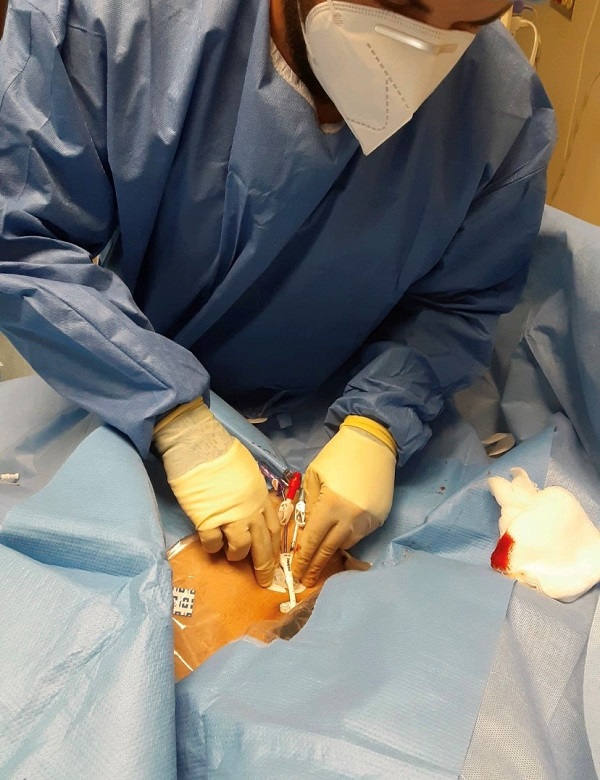
Shoals Kidney Center placing a Vas Cath Central Venous Line to be used for Temporary Dialysis
Vas Cath Placement at the Bedside
Vas Cath Placement at the Bedside is performed by Shoals Kidney Center, and can be advantageous. While Vas Cath Lines can be placed in the interventional radiology department by hospital clinicians, placement of these Lines at the Bedside by Vascular Access Clinicians can prove valuable. Vas Cath insertion and placement at the bedside can be beneficial for many of the same reasons other Central Venous Lines at the bedside can be preferable including more effective infection control, decreased transportation time and expense, easier coordination of treatment, less patient disruption, decreased length of stay for the patient, and improved efficiency and use of resources such as facilities, equipment, supplies and medical specialists. Since Vas Cath Lines serve the important purpose of the Kidney function, speed is critical especially in the case of suspected Temporary Renal Failure where Kidney preservation and restoration is feasible and desirable. Vascular Access clinicians who can provide Vas Cath placement at the bedside and then read a confirmation X-Ray to confirm tip placement, can clear the Vas Cath Line for usage often much quicker than other options. Contrast Dye Neuropathy (CIN) rates are high in the renal population and using the bedside dye-free approach and ultrasound eliminates this risk. Vas Cath or Temporary Dialysis Catheters at the Bedside serve the important purpose of providing immediate care without disrupting future care options enabling the patient’s care plan to be carefully developed.
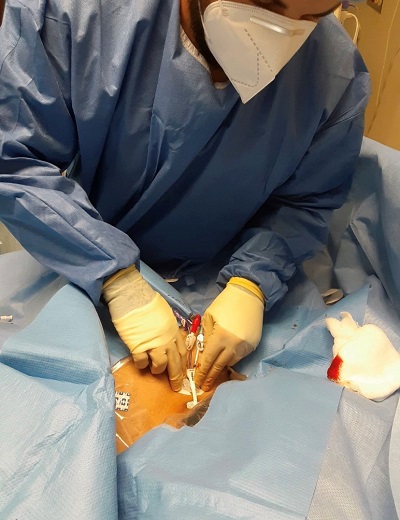
Shoals Kidney Center placing a Vas Cath Central Venous Line to be used for Temporary Dialysis
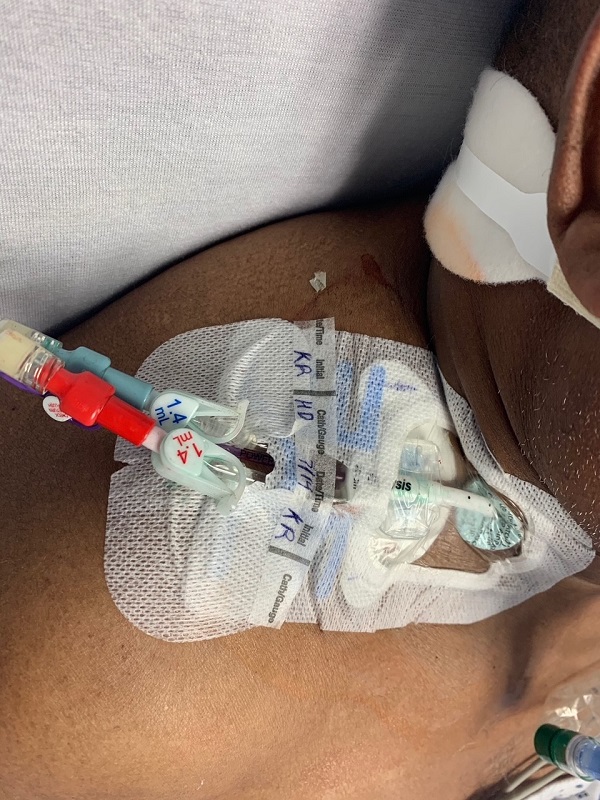
Vas Cath Central Venous Line successfully placed, confirmed, and ready for use
Dialysis Catheter Infection Prevention and Control
Dialysis Catheter Infection Prevention and Control is incredibly important because veins are limited and non-renewable resources and treating infections can result in additional vein usage. Shoals Kidney Center approach of placing Large Bore Catheters anatomically lower and near the clavicle, makes care and maintenance of the line much easier than when the Catheter is placed high on the neck. Further, Shoals Kidney Center has proven success with Statlock Stabilization, a sutureless approach, which further mitigates risk of a Central Line Associated Bloodstream Infection (CLABSI). Finally, the Vas Cath can be clinically appropriate therapy when a Permanent Dialysis Catheter becomes infected and must be removed. Since the patient still requires dialysis, the Vas Cath can enable such treatment until the infection is cleared at which point a replacement Permanent Dialysis Catheter can be provided and the Vas Cath is removed. This approach protects the replacement Permanent Dialysis Catheter from acquiring the same infection and then having to be removed as well. Inserting and removing Permanent Dialysis Catheters decreases a patient’s expected life span as veins and arteries get consumed and are no longer available for later use.
Dialysis Catheter Infection Prevention and Control
Dialysis Catheter Infection Prevention and Control is incredibly important because veins are limited and non-renewable resources and treating infections can result in additional vein usage. Shoals Kidney Center approach of placing Large Bore Catheters anatomically lower and near the clavicle, makes care and maintenance of the line much easier than when the Catheter is placed high on the neck. Further, Shoals Kidney Center has proven success with Statlock Stabilization, a sutureless approach, which further mitigates risk of a Central Line Associated Bloodstream Infection (CLABSI). Finally, the Vas Cath can be clinically appropriate therapy when a Permanent Dialysis Catheter becomes infected and must be removed. Since the patient still requires dialysis, the Vas Cath can enable such treatment until the infection is cleared at which point a replacement Permanent Dialysis Catheter can be provided and the Vas Cath is removed. This approach protects the replacement Permanent Dialysis Catheter from acquiring the same infection and then having to be removed as well. Inserting and removing Permanent Dialysis Catheters decreases a patient’s expected life span as veins and arteries get consumed and are no longer available for later use.

Vas Cath Central Venous Line successfully placed, confirmed, and ready for use
Shoals Kidney Center – Vas Cath Placement Expert
Shoals Kidney Center is a Vas Cath Placement Expert the clinicians at Shoals kidney and hypertension Center strive to provide the highest quality of vascular access to serve our patients in need.

National Kidney Foundation

Centers for Disease Control

Association of Vascular Access

Advanced Cardiovascular Life Support
Shoals Kidney Center – Vas Cath Placement Expert
Shoals Kidney Center is a Vas Cath Placement Expert the clinicians at Shoals kidney and hypertension Center strive to provide the highest quality of vascular access to serve our patients in need.

National Kidney Foundation

Centers for Disease Control

Association of Vascular Access

Advanced Cardiovascular Life Support
Like any medical procedure, the insertion of a Central Venous Catheter (CVC) can have potential complications. Such complications are severely mitigated when an experienced and trained clinician uses best practices like the clinicians at Vascular Wellness. While potential complications exist, there are tremendous benefits of a CVC such as the means to deliver medications, infusions, and fluid over a longer period of time especially those that can be more toxic or caustic or need higher flow rates. In other words, these potential complications should not deter the usage of the Central Line as most medical treatments start with Vascular Access.
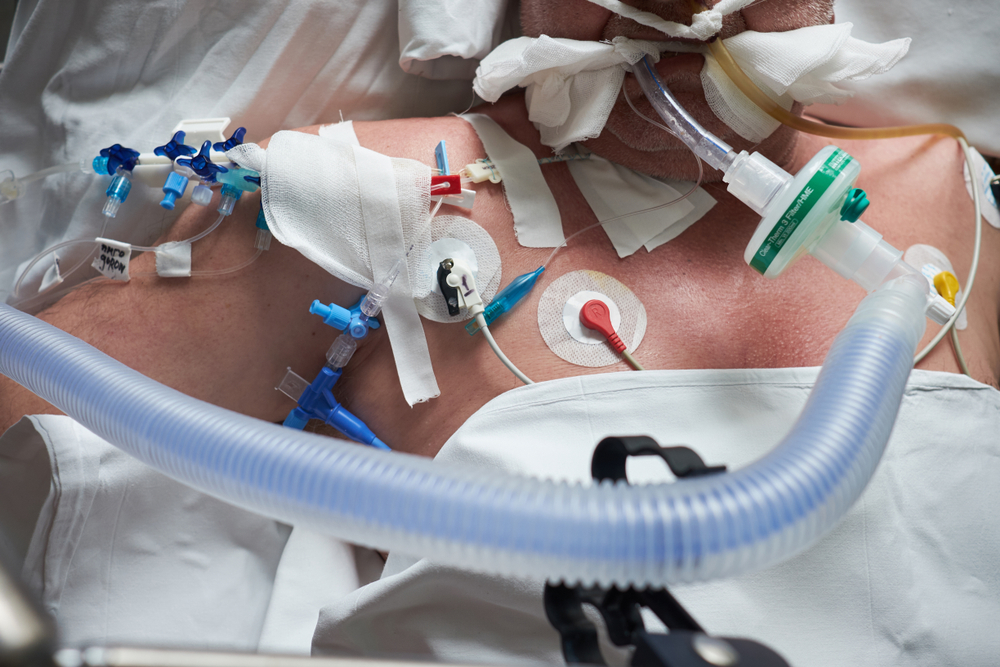
Like any medical procedure, the insertion of a Central Venous Catheter (CVC) can have potential complications. Such complications are severely mitigated when an experienced and trained clinician uses best practices like the clinicians at Vascular Wellness. While potential complications exist, there are tremendous benefits of a CVC such as the means to deliver medications, infusions, and fluid over a longer period of time especially those that can be more toxic or caustic or need higher flow rates. In other words, these potential complications should not deter the usage of the Central Line as most medical treatments start with Vascular Access.

What are the types of potential complications of a Central Line?
Complications can arise during and from the procedure (ie, the placement of CVC) and later while the CVC is in the patient even if not actively in use. Some of the possible complications in no particular order include the following:
Central Line-Associated Bloodstream Infection (CLABSI)
Bacteria from the skin can access the body at the CVC line insertion site. For example, the CVC insertion site should be monitored and scheduled sterile dressing changes and skin cleanings at the site should be considered. A CVC placed in a fold such as in the elbow or groin area is more prone to bacteria and infections and thus, should be avoided which is why, for example, a poorly placed CVC in the groin to access the femoral vein can expose the patient to infection.
Collapsed Lung (Pneumothorax)
The needle in the CVC placed in the neck or chest can go through the vein or miss the vein and could pierce the lung, causing the lung to collapse. If this happens, a small tube is used to re-inflate the lung.
Delayed Pneumothorax (after 24 hours)
A patient who has symptoms of shortness of breath, cough, or chest pain after a vascular access procedure may be suffering from this complication. If so, the patient should alert the nurse if still under care and treatment at a medical facility or go to the emergency room if outpatient.
Artery Puncture
This can happen when the needle punctures an artery instead of the vein during the insertion process. The use of ultrasound reduces the risk as it helps guides the needle to the proper vein and distinguishes a vein from an artery. A punctured artery can cause a Hematoma, which occurs when blood collects outside the artery.
Nerve or Vein injury
The can occur if the needle hits the nerve or vein during insertion. Inflammation of the vein (Phlebitis) can also happen. This risk is also reduced with a clinician who has mastery use of ultrasound guided technology.
Blood Clot (Thrombus)
The CVC can create a blood clot, causing the flow of blood to be blocked or impaired. It generally needs immediate attention especially if the blood clot travels through the blood vessels and creates a blockage of blood flow to the heart, lungs (pulmonary embolism), brain or other organs.
Air Bubble in the Blood (Air Embolism)
During the CVC insertion, air may enter the vein. An air embolism, like a blood clot, can travel through the blood vessels and block the flow of blood to the heart, lungs, brain, or other organs. Immediate attention is generally required.
Irregular Heartbeat
This may happen during the line insertion near the heart and usually resolves after the line is in place.
What are the signs of potential complications of a Central Line?
While the CVC is inserted, it is important to be on the lookout for problems with the catheter. The catheter may become infected, blocked, or start coming out of the vein. If the catheter is red, tender or has swelling at the insertion site, it may be infected. If the catheter line is difficult to flush, it may be blocked. Sometimes blood can flow back in to the CVC tubing and form clots or the line may kink. If the catheter seems to be increasing in length outside the skin, it may be coming out of the vein. To help mitigate risk of infection and some of these other issues, Central Line Care is extremely important. See PICC Line and Midline Catheter Care | Vascular Wellness
How do you reduce the risk of complications of a Central Line?
Expertise using Ultra-Sound, experience with the touch and feel of threading the CVC, and constant practice and use of this skill set is essential. The best Vascular Access Clinicians are those that specialize in this highly regarded and necessary practice area for medical treatment.


